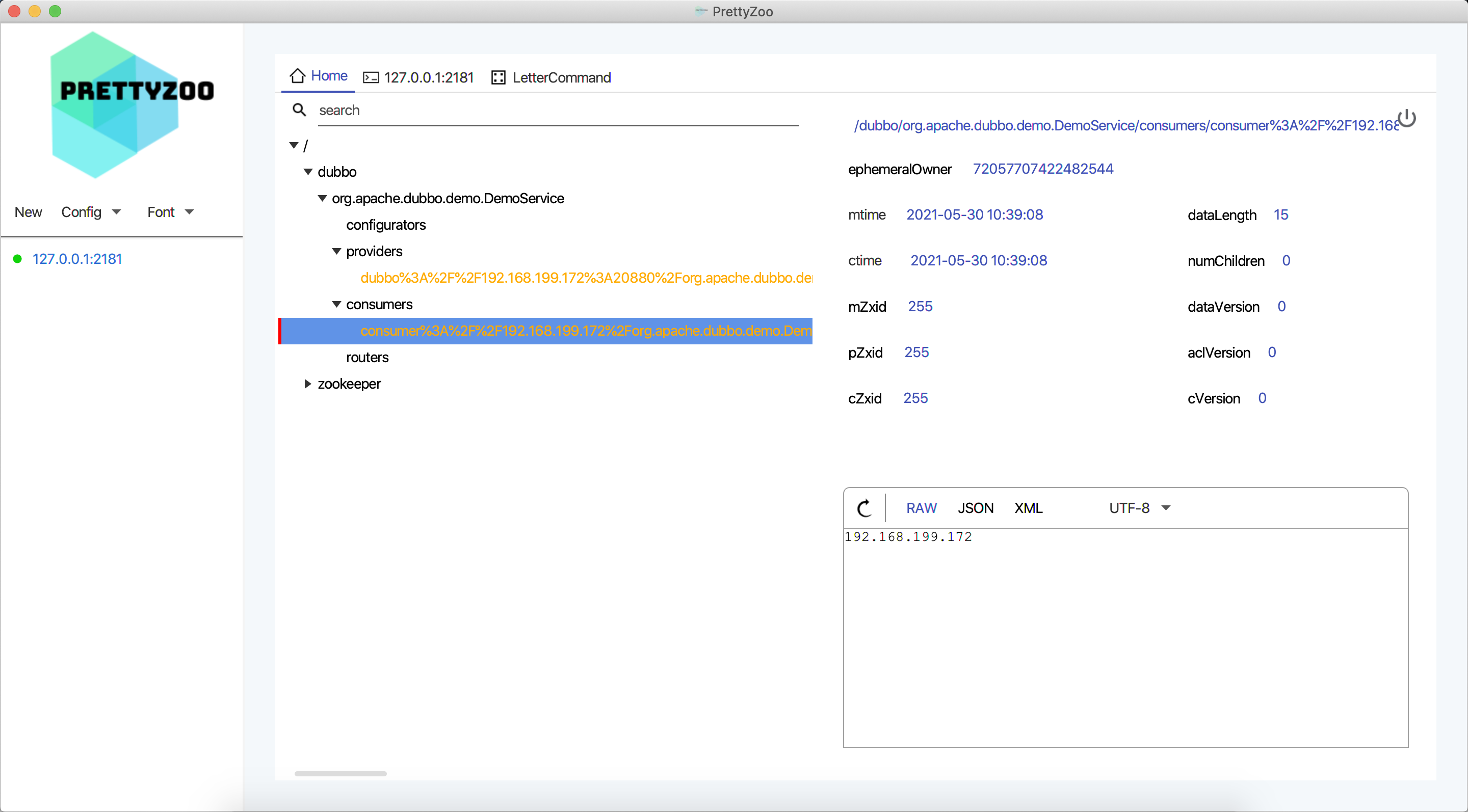一、服务引入整体流程

二、ReferenceConfig#get
ReferenceConfig.get方法首次调用会调用init方法对ref初始化。
1
2
3
4
5
6
7
8
9
10
11
12
13
14
15
16
17
18
19
20
21
22
23
24
25
26
27
28
29
30
31
32
33
34
35
36
37
38
39
40
41
42
43
44
45
46
47
48
49
50
51
52
53
54
55
56
57
58
59
60
61
62
63
64
65
66
67
68
69
70
71
72
73
74
75
76
77
78
79
80
81
82
83
84
85
86
87
88
89
90
91
92
93
94
95
96
97
98
99
100
101
102
103
104
| public class ReferenceConfig<T> extends ReferenceConfigBase<T> {
public synchronized void init() {
if (initialized) {
return;
}
if (bootstrap == null) {
bootstrap = DubboBootstrap.getInstance();
bootstrap.init();
}
checkAndUpdateSubConfigs();
serviceMetadata.setVersion(version);
serviceMetadata.setGroup(group);
serviceMetadata.setDefaultGroup(group);
serviceMetadata.setServiceType(getActualInterface());
serviceMetadata.setServiceInterfaceName(interfaceName);
serviceMetadata.setServiceKey(URL.buildKey(interfaceName, group, version));
checkStubAndLocal(interfaceClass);
ConfigValidationUtils.checkMock(interfaceClass, this);
Map<String, String> map = new HashMap<String, String>();
map.put(SIDE_KEY, CONSUMER_SIDE);
ReferenceConfigBase.appendRuntimeParameters(map);
if (!ProtocolUtils.isGeneric(generic)) {
String revision = Version.getVersion(interfaceClass, version);
if (revision != null && revision.length() > 0) {
map.put(REVISION_KEY, revision);
}
String[] methods = Wrapper.getWrapper(interfaceClass).getMethodNames();
if (methods.length == 0) {
logger.warn("No method found in service interface " + interfaceClass.getName());
map.put(METHODS_KEY, ANY_VALUE);
} else {
map.put(METHODS_KEY, StringUtils.join(new HashSet<String>(Arrays.asList(methods)), COMMA_SEPARATOR));
}
}
map.put(INTERFACE_KEY, interfaceName);
AbstractConfig.appendParameters(map, getMetrics());
AbstractConfig.appendParameters(map, getApplication());
AbstractConfig.appendParameters(map, getModule());
AbstractConfig.appendParameters(map, consumer);
AbstractConfig.appendParameters(map, this);
Map<String, Object> attributes = null;
if (CollectionUtils.isNotEmpty(getMethods())) {
attributes = new HashMap<>();
for (MethodConfig methodConfig : getMethods()) {
AbstractConfig.appendParameters(map, methodConfig, methodConfig.getName());
String retryKey = methodConfig.getName() + ".retry";
if (map.containsKey(retryKey)) {
String retryValue = map.remove(retryKey);
if ("false".equals(retryValue)) {
map.put(methodConfig.getName() + ".retries", "0");
}
}
ConsumerModel.AsyncMethodInfo asyncMethodInfo = AbstractConfig.convertMethodConfig2AsyncInfo(methodConfig);
if (asyncMethodInfo != null) {
attributes.put(methodConfig.getName(), asyncMethodInfo);
}
}
}
String hostToRegistry = ConfigUtils.getSystemProperty(DUBBO_IP_TO_REGISTRY);
if (StringUtils.isEmpty(hostToRegistry)) {
hostToRegistry = NetUtils.getLocalHost();
} else if (isInvalidLocalHost(hostToRegistry)) {
throw new IllegalArgumentException("Specified invalid registry ip from property:" + DUBBO_IP_TO_REGISTRY + ", value:" + hostToRegistry);
}
map.put(REGISTER_IP_KEY, hostToRegistry);
serviceMetadata.getAttachments().putAll(map);
ServiceRepository repository = ApplicationModel.getServiceRepository();
ServiceDescriptor serviceDescriptor = repository.registerService(interfaceClass);
repository.registerConsumer(
serviceMetadata.getServiceKey(),
attributes,
serviceDescriptor,
this,
null,
serviceMetadata);
ref = createProxy(map);
serviceMetadata.setTarget(ref);
serviceMetadata.addAttribute(PROXY_CLASS_REF, ref);
repository.lookupReferredService(serviceMetadata.getServiceKey()).setProxyObject(ref);
initialized = true;
dispatch(new ReferenceConfigInitializedEvent(this, invoker));
}
}
|
ReferenceConfig#checkAndUpdateSubConfigs设置配置优先级
checkAndUpdateSubConfigs里调用this.refresh();方法进行配置优先级设定。
1
2
3
4
5
6
7
8
9
10
11
12
13
| public void refresh() {
Environment env = ApplicationModel.getEnvironment();
try {
CompositeConfiguration compositeConfiguration = env.getConfiguration(getPrefix(), getId());
Configuration config = new ConfigConfigurationAdapter(this);
if (env.isConfigCenterFirst()) {
compositeConfiguration.addConfiguration(4, config);
} else {
compositeConfiguration.addConfiguration(2, config);
}
}
|
其中,Environment#getConfiguration
1
2
3
4
5
6
7
8
9
10
11
12
13
14
15
16
17
| public class Environment extends LifecycleAdapter implements FrameworkExt {
public CompositeConfiguration getConfiguration(String prefix, String id) {
CompositeConfiguration compositeConfiguration = new CompositeConfiguration();
compositeConfiguration.addConfiguration(this.getSystemConfig(prefix, id));
compositeConfiguration.addConfiguration(this.getEnvironmentConfig(prefix, id));
compositeConfiguration.addConfiguration(this.getAppExternalConfig(prefix, id));
compositeConfiguration.addConfiguration(this.getExternalConfig(prefix, id));
compositeConfiguration.addConfiguration(this.getPropertiesConfig(prefix, id));
return compositeConfiguration;
}
}
|
三、ReferenceConfig#createProxy(一)
1
2
3
4
5
6
7
8
9
10
11
12
13
14
15
16
17
18
19
20
21
22
23
24
25
26
27
28
29
30
31
32
33
34
35
36
37
38
39
40
41
42
43
44
45
46
47
48
49
50
51
52
53
54
55
56
57
58
59
60
61
62
63
64
65
66
67
68
69
70
71
72
73
74
75
| public class ReferenceConfig<T> extends ReferenceConfigBase<T> {
private static final Protocol REF_PROTOCOL = ExtensionLoader.getExtensionLoader(Protocol.class).getAdaptiveExtension();
private T createProxy(Map<String, String> map) {
if (shouldJvmRefer(map)) {
URL url = new URL(LOCAL_PROTOCOL, LOCALHOST_VALUE, 0, interfaceClass.getName()).addParameters(map);
invoker = REF_PROTOCOL.refer(interfaceClass, url);
} else {
urls.clear();
if (url != null && url.length() > 0) {
String[] us = SEMICOLON_SPLIT_PATTERN.split(url);
if (us != null && us.length > 0) {
for (String u : us) {
URL url = URL.valueOf(u);
if (StringUtils.isEmpty(url.getPath())) {
url = url.setPath(interfaceName);
}
if (UrlUtils.isRegistry(url)) {
urls.add(url.addParameterAndEncoded(REFER_KEY, StringUtils.toQueryString(map)));
} else {
urls.add(ClusterUtils.mergeUrl(url, map));
}
}
}
} else {
if (!LOCAL_PROTOCOL.equalsIgnoreCase(getProtocol())) {
checkRegistry();
List<URL> us = ConfigValidationUtils.loadRegistries(this, false);
if (CollectionUtils.isNotEmpty(us)) {
for (URL u : us) {
URL monitorUrl = ConfigValidationUtils.loadMonitor(this, u);
if (monitorUrl != null) {
map.put(MONITOR_KEY, URL.encode(monitorUrl.toFullString()));
}
urls.add(u.addParameterAndEncoded(REFER_KEY, StringUtils.toQueryString(map)));
}
}
if (urls.isEmpty()) {
throw new IllegalStateException("No such any registry to reference, please config <dubbo:registry address=\"...\" /> to your spring config.");
}
}
}
if (urls.size() == 1) {
invoker = REF_PROTOCOL.refer(interfaceClass, urls.get(0));
} else {
List<Invoker<?>> invokers = new ArrayList<Invoker<?>>();
URL registryURL = null;
for (URL url : urls) {
invokers.add(REF_PROTOCOL.refer(interfaceClass, url));
if (UrlUtils.isRegistry(url)) {
registryURL = url;
}
}
if (registryURL != null) {
URL u = registryURL.addParameterIfAbsent(CLUSTER_KEY, ZoneAwareCluster.NAME);
invoker = CLUSTER.join(new StaticDirectory(u, invokers));
} else {
invoker = CLUSTER.join(new StaticDirectory(invokers));
}
}
}
if (shouldCheck() && !invoker.isAvailable()) {
throw new IllegalStateException("No provider available for the service");
}
return (T) PROXY_FACTORY.getProxy(invoker);
}
}
|
四、REF_PROTOCOL#refer
REF_PROTOCOL是Protoco扩展点的自适应类。其会根据URL的protocol属性获取实现类
1
| Protocol REF_PROTOCOL = ExtensionLoader.getExtensionLoader(Protocol.class).getAdaptiveExtension();
|
正常通过注册中心进行refer时,url格式类似,其会获取RegistryProtocol类并调用refer方法:

RegistryProtocol#refer方法,会对URL进行重写,然后调用doRefer。
1
2
3
4
5
6
7
8
9
10
11
12
13
14
15
16
17
18
19
20
21
| public class RegistryProtocol implements Protocol {
public <T> Invoker<T> refer(Class<T> type, URL url) throws RpcException {
url = getRegistryUrl(url);
Registry registry = registryFactory.getRegistry(url);
if (RegistryService.class.equals(type)) {
return proxyFactory.getInvoker((T) registry, type, url);
}
Map<String, String> qs = StringUtils.parseQueryString(url.getParameterAndDecoded(REFER_KEY));
String group = qs.get(GROUP_KEY);
if (group != null && group.length() > 0) {
if ((COMMA_SPLIT_PATTERN.split(group)).length > 1 || "*".equals(group)) {
return doRefer(getMergeableCluster(), registry, type, url);
}
}
return doRefer(cluster, registry, type, url);
}
}
|
重写后的URL为:
而根据URL获取的Registry为:

五、RegistryProtocol#doRefer
1
2
3
4
5
6
7
8
9
10
11
12
13
14
15
16
17
18
19
20
| public class RegistryProtocol implements Protocol {
private <T> Invoker<T> doRefer(Cluster cluster, Registry registry, Class<T> type, URL url) {
RegistryDirectory<T> directory = new RegistryDirectory<T>(type, url);
directory.setRegistry(registry);
directory.setProtocol(protocol);
Map<String, String> parameters = new HashMap<String, String>(directory.getUrl().getParameters());
URL subscribeUrl = new URL(CONSUMER_PROTOCOL, parameters.remove(REGISTER_IP_KEY), 0, type.getName(), parameters);
if (!ANY_VALUE.equals(url.getServiceInterface()) && url.getParameter(REGISTER_KEY, true)) {
directory.setRegisteredConsumerUrl(getRegisteredConsumerUrl(subscribeUrl, url));
registry.register(directory.getRegisteredConsumerUrl());
}
directory.buildRouterChain(subscribeUrl);
directory.subscribe(subscribeUrl.addParameter(CATEGORY_KEY,
PROVIDERS_CATEGORY + "," + CONFIGURATORS_CATEGORY + "," + ROUTERS_CATEGORY));
Invoker invoker = cluster.join(directory);
return invoker;
}
}
|
该方法会根据前面获取的注册中心示例Regitry,URL等信息构建RegistryDirectory,然后调用RegistryDirectory#subscribe向注册中心注册Consumer信息,获取并持续监听Provider信息。
此时设置进RegistryDirectory的URL格式为:
1.RegistryDirectory#subscribe

该方法内会调用注册中心实例的subscribe方法,并把自己作为Listener传入。自此当前的调用链如上图。
1
2
3
4
5
6
7
8
| public class RegistryDirectory<T> extends AbstractDirectory<T> implements NotifyListener {
public void subscribe(URL url) {
setConsumerUrl(url);
CONSUMER_CONFIGURATION_LISTENER.addNotifyListener(this);
serviceConfigurationListener = new ReferenceConfigurationListener(this, url);
registry.subscribe(url, this);
}
}
|
2.ZookeeperRegistry#doSubcribe
1
2
3
4
5
6
7
8
9
10
11
12
13
14
15
16
17
18
19
20
21
22
23
24
25
26
27
28
29
30
31
32
33
34
35
36
37
38
39
40
41
42
43
44
45
46
47
48
49
50
51
52
53
54
55
56
57
58
59
60
61
62
63
64
| public class ZookeeperRegistry extends FailbackRegistry {
public void doSubscribe(final URL url, final NotifyListener listener) {
try {
if (ANY_VALUE.equals(url.getServiceInterface())) {
String root = toRootPath();
ConcurrentMap<NotifyListener, ChildListener> listeners = zkListeners.get(url);
if (listeners == null) {
zkListeners.putIfAbsent(url, new ConcurrentHashMap<>());
listeners = zkListeners.get(url);
}
ChildListener zkListener = listeners.get(listener);
if (zkListener == null) {
listeners.putIfAbsent(listener, (parentPath, currentChilds) -> {
for (String child : currentChilds) {
child = URL.decode(child);
if (!anyServices.contains(child)) {
anyServices.add(child);
subscribe(url.setPath(child).addParameters(INTERFACE_KEY, child,
Constants.CHECK_KEY, String.valueOf(false)), listener);
}
}
});
zkListener = listeners.get(listener);
}
zkClient.create(root, false);
List<String> services = zkClient.addChildListener(root, zkListener);
if (CollectionUtils.isNotEmpty(services)) {
for (String service : services) {
service = URL.decode(service);
anyServices.add(service);
subscribe(url.setPath(service).addParameters(INTERFACE_KEY, service,
Constants.CHECK_KEY, String.valueOf(false)), listener);
}
}
} else {
List<URL> urls = new ArrayList<>();
for (String path : toCategoriesPath(url)) {
ConcurrentMap<NotifyListener, ChildListener> listeners = zkListeners.get(url);
if (listeners == null) {
zkListeners.putIfAbsent(url, new ConcurrentHashMap<>());
listeners = zkListeners.get(url);
}
ChildListener zkListener = listeners.get(listener);
if (zkListener == null) {
listeners.putIfAbsent(listener, (parentPath, currentChilds) -> ZookeeperRegistry.this.notify(url, listener, toUrlsWithEmpty(url, parentPath, currentChilds)));
zkListener = listeners.get(listener);
}
zkClient.create(path, false);
List<String> children = zkClient.addChildListener(path, zkListener);
if (children != null) {
urls.addAll(toUrlsWithEmpty(url, path, children));
}
}
notify(url, listener, urls);
}
} catch (Throwable e) {
throw new RpcException("Failed to subscribe " + url + " to zookeeper " + getUrl() + ", cause: " + e.getMessage(), e);
}
}
}
|
其中,toCategoriesPath(url)会构建三个监听的URL,当以下Zookeeper的三个目录发生变化时,会触发ZookeeperRegistry#notify方法。
1
2
3
| 0 = "/dubbo/org.apache.dubbo.demo.DemoService/providers"
1 = "/dubbo/org.apache.dubbo.demo.DemoService/configurators"
2 = "/dubbo/org.apache.dubbo.demo.DemoService/routers"
|
3.ZookeeperRegistry#notify
该方法最终会调用其父类AbstractRegistry的notify方法,该方法中会遍历上面传入的三个Path,调用listener#notify。而listener即是RegistryDirectory。
1
2
3
4
5
6
7
8
9
10
11
12
13
14
15
16
17
18
19
20
21
22
23
24
25
26
| public abstract class AbstractRegistry implements Registry {
protected void notify(URL url, NotifyListener listener, List<URL> urls) {
Map<String, List<URL>> result = new HashMap<>();
for (URL u : urls) {
if (UrlUtils.isMatch(url, u)) {
String category = u.getParameter(CATEGORY_KEY, DEFAULT_CATEGORY);
List<URL> categoryList = result.computeIfAbsent(category, k -> new ArrayList<>());
categoryList.add(u);
}
}
if (result.size() == 0) {
return;
}
Map<String, List<URL>> categoryNotified = notified.computeIfAbsent(url, u -> new ConcurrentHashMap<>());
for (Map.Entry<String, List<URL>> entry : result.entrySet()) {
String category = entry.getKey();
List<URL> categoryList = entry.getValue();
categoryNotified.put(category, categoryList);
listener.notify(categoryList);
saveProperties(url);
}
}
}
|
当前调用链为:

4. RegistryDirectory#notify
该方法最终会根据Provider目录的URL,调用RegistryDirectory#toInvoker构建Invoker实例的Map,provider的URL示例如下:
构建Inovker语句如下:
1
| invoker = new InvokerDelegate<>(protocol.refer(serviceType, url), url, providerUrl);
|
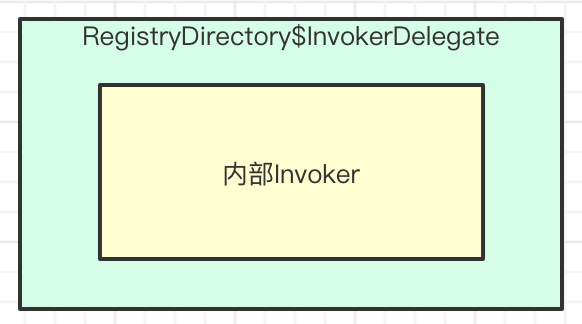
调用链为:
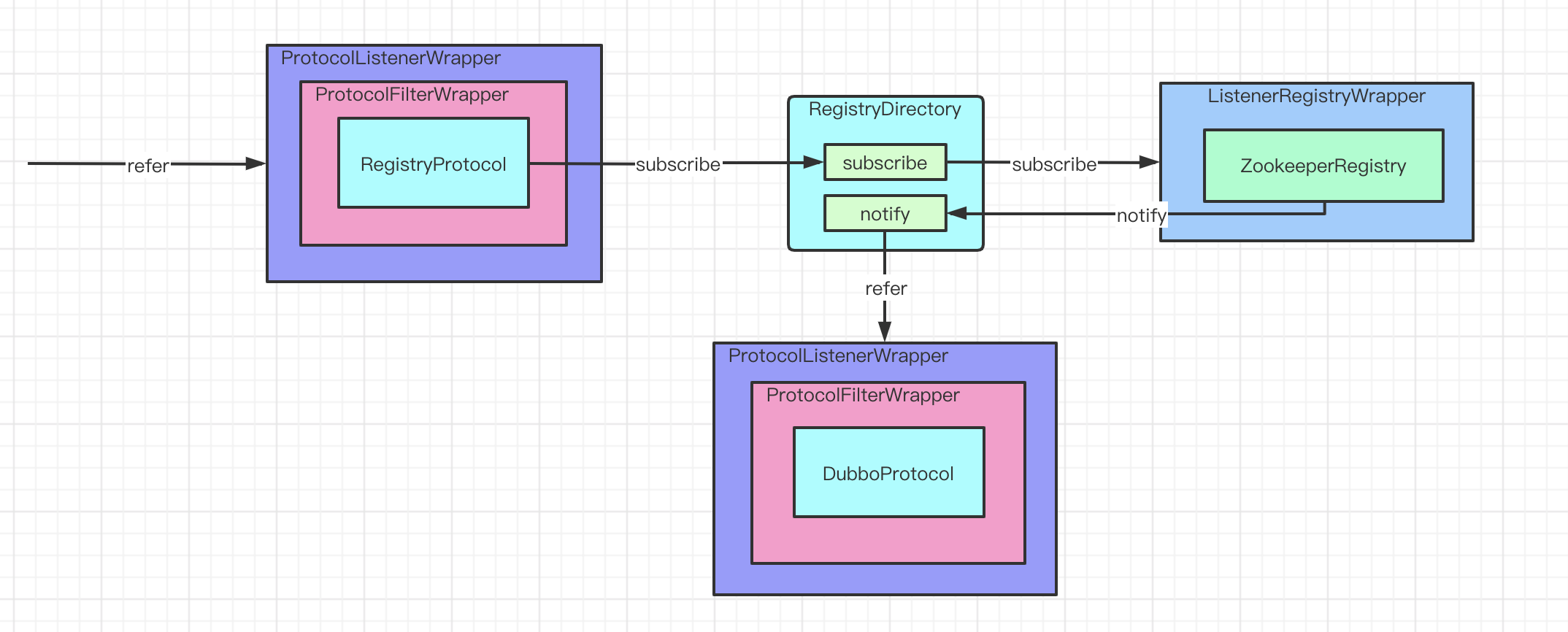
5.DubboProtocol#refer
1)两个包装类
调用DubboProtocol#refer前会调用其两个包装类,对其返回的Invoker进行封装。
1
2
3
4
5
6
7
8
9
10
| public class ProtocolListenerWrapper implements Protocol {
public <T> Invoker<T> refer(Class<T> type, URL url) throws RpcException {
if (UrlUtils.isRegistry(url)) {
return protocol.refer(type, url);
}
return new ListenerInvokerWrapper<T>(protocol.refer(type, url),
Collections.unmodifiableList(
ExtensionLoader.getExtensionLoader(InvokerListener.class).getActivateExtension(url, INVOKER_LISTENER_KEY)));
}
}
|
1
2
3
4
5
6
7
8
| public class ProtocolFilterWrapper implements Protocol {
public <T> Invoker<T> refer(Class<T> type, URL url) throws RpcException {
if (UrlUtils.isRegistry(url)) {
return protocol.refer(type, url);
}
return buildInvokerChain(protocol.refer(type, url), REFERENCE_FILTER_KEY, CommonConstants.CONSUMER);
}
}
|

2) DubboProtocol#refer
1
2
3
4
5
6
7
8
9
10
11
12
13
14
15
16
17
| public abstract class AbstractProtocol implements Protocol {
public <T> Invoker<T> refer(Class<T> type, URL url) throws RpcException {
return new AsyncToSyncInvoker<>(protocolBindingRefer(type, url));
}
}
public class DubboProtocol extends AbstractProtocol {
public <T> Invoker<T> protocolBindingRefer(Class<T> serviceType, URL url) throws RpcException {
optimizeSerialization(url);
DubboInvoker<T> invoker = new DubboInvoker<T>(serviceType, url, getClients(url), invokers);
invokers.add(invoker);
return invoker;
}
}
|
根据以上代码可知,最终生成的Invoker结构为:
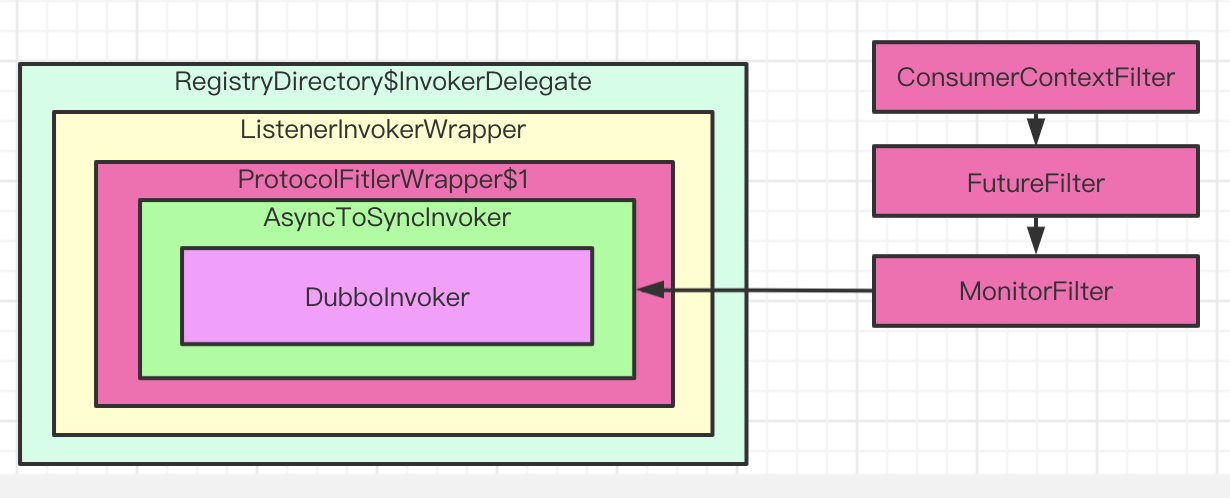
6. DubboProcotol#getClients
该方法最终会调用Exchanges#connect,和服务的Provider建立连接。
1
| Exchangers.connect(url, requestHandler);
|
而,Exchanges会调用HeaderExchanger进行connet。
1
2
3
4
5
| public class HeaderExchanger implements Exchanger {
public ExchangeClient connect(URL url, ExchangeHandler handler) throws RemotingException {
return new HeaderExchangeClient(Transporters.connect(url, new DecodeHandler(new HeaderExchangeHandler(handler))), true);
}
}
|
六、RegistryProtocol#doRefer(二)
RegistryDirectory#subscribe执行结束后,会调用如下方法,此处cluster是扩展点自动注入的Cluster扩展点的自适应类。
1
| Invoker invoker = cluster.join(directory);
|
cluster扩展点的包装如下:
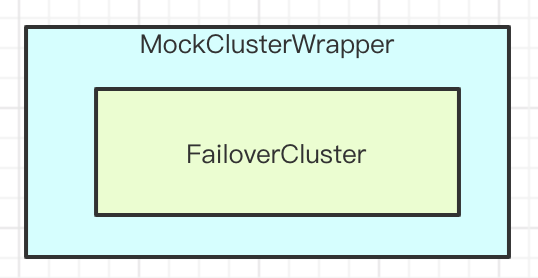
1
2
3
4
5
6
7
8
9
10
11
12
13
14
15
16
17
18
19
20
21
| public class MockClusterWrapper implements Cluster {
private Cluster cluster;
public MockClusterWrapper(Cluster cluster) {
this.cluster = cluster;
}
@Override
public <T> Invoker<T> join(Directory<T> directory) throws RpcException {
return new MockClusterInvoker<T>(directory, this.cluster.join(directory));
}
}
public class FailoverCluster extends AbstractCluster {
public final static String NAME = "failover";
@Override
public <T> AbstractClusterInvoker<T> doJoin(Directory<T> directory) throws RpcException {
return new FailoverClusterInvoker<>(directory);
}
}
|
经过cluster#join后,Invoker结构如下:

其中,FailoverCluster中包含负载均衡算法,在调用时选择合适的Invoker进行调用。
七、ReferenceConfig#createProxy(二)
ReferenceConfig会对REF_PROTOCOL#refer的invoker,调用ProxyFactory扩展点生成引用接口的代理。
1
| PROXY_FACTORY.getProxy(invoker);
|
消费者在Zookeeper注册信息如下:
1
| /dubbo/org.apache.dubbo.demo.DemoService/consumers/consumer%3A%2F%2F192.168.199.172%2Forg.apache.dubbo.demo.DemoService%3Fapplication%3Ddubbo-demo-api-consumer%26category%3Dconsumers%26check%3Dfalse%26dubbo%3D2.0.2%26interface%3Dorg.apache.dubbo.demo.DemoService%26methods%3DsayHello%2CsayHelloAsync%26pid%3D59082%26side%3Dconsumer%26sticky%3Dfalse%26timestamp%3D1622342348716
|
URL Decode:
1
| /dubbo/org.apache.dubbo.demo.DemoService/consumers/consumer:
|
